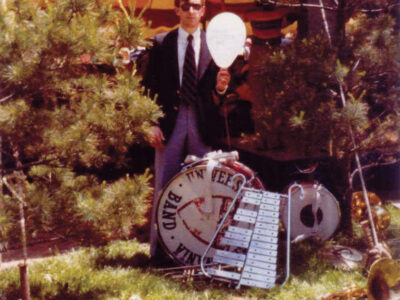
The Netter Center celebrates 25 years—and takes a hard look at how university-community partnerships should change.
“Universities are not succeeding at what they’re supposed to do,” declared Ira Harkavy C’70 Gr’79, the founding director of Penn’s Netter Center for Community Partnerships. “We’re doing more and better, but we are not connected to the world we need to be connected to.”
Considering the occasion—the culmination of a two-day conference celebrating the Netter Center’s 25th anniversary—it was a curious choice of parting thoughts. Since its inception in 1992, the Netter Center has played a leading role in the University’s efforts to revitalize West Philadelphia. With a mission dedicated to community development and service, it pioneered a new curricular category at Penn: the academically based community service course, or ABCS. Last year there were 70 such courses, across eight of the University’s schools. Through them, approximately 1,700 undergraduate and graduate students worked with community organizations and residents of all ages. The academic subject matter ranged from pediatric acute care for nurse practitioner students, to a course on the urban asthma epidemic rooted in collaborations with community centers and a Children’s Hospital of Philadelphia-led research study, to a Penn Engineering course on indoor LED-powered gardening systems based in two public schools.
In other words, the Netter Center has much to be proud of. And conference presenters and attendees—hailing from as close by as the Philadelphia Mayor’s Office and as far as Spain—frequently praised it as a role model. Yet Harkavy’s closing remarks reflected a gnawing sense of uncertainty, verging on crisis, that permeated the proceedings.
These are anxious times for academic institutions. This past July, the Pew Research Center reported a startling partisan shift in attitudes about US higher education. Since 2010, poll respondents have, by and large, expressed positive opinions about the impact of colleges and universities on American life. But since 2015, approval among Republicans has nose-dived. In 2017, while 72 percent of Democrats polled indicated that “American colleges and universities have a positive effect on the way things are going in the country,” only 36 percent of Republicans agreed—and 58 percent said these institutions have a “negative” effect.
The first day of the conference brought fresh worries about the consequences of faltering public support for higher education. The US House of Representatives passed a tax bill that would end the student loan interest deduction; eliminate the Lifetime Learning tax credit (often used on courses to acquire new job skills); tax large private university endowments; and treat graduate-level tuition assistance as taxable income, overturning a critical financial tool relied upon by roughly 145,000 students—most of whom work in science, technology, engineering, and math disciplines.
Meanwhile, the seemingly inexorable escalation of tuition costs and student debt has caused Americans across the political spectrum to question whether a degree is worth it. Questions have also emerged about the sufficiency of well-intentioned neighborhood revitalization efforts by urban universities. Meaghan Ehlenz GCP’15, who presented research on this topic, has argued that while Penn’s strategy in West Philadelphia—now widely considered “best practice” in the field—delivered substantial positive impacts on property values, public safety, and amenities (generated chiefly by its support for a new public neighborhood school, Penn Alexander), “these upward trends masked continued socioeconomic decline” outside the small Penn Alexander catchment area. Her current research finds similar “bifurcations” in communities adjacent to 22 universities across the country.
“[John] Dewey said that the greatest intellectual progress occurs when human beings work collectively and collaboratively on the most pressing problems of life,” Harkavy said. “What’s a more pressing problem of life than racism? What’s a more pressing problem than poverty, and inadequate schooling? And where is it lived? It is lived in the neighborhoods.”
But if life in the shadow of great urban universities has only gotten better for a fortunate portion, and if higher education seems increasingly out of reach for those left behind—be they poor children, downsized manufacturing workers, or combat veterans returning to civilian life—how must American universities respond?
“The model that we have often operated on, in which higher education is the access to the middle class,” said Brian Murphy, president of De Anza College (a lauded community college south of San Francisco), “may be entirely trumped by a set of public policies and the use of power which makes our efforts, however laudable, not very significant.”
So higher-ed institutions must both recommit themselves to community engagement, he and others argued, and change how they go about it.
During the conference’s closing panel, Murphy suggested that “one of the intellectual challenges” in neighborhood-based community engagement work is going beyond traditional service to “talk about power in its broadest dimension”: ensuring that “students are learning as well how to confront the genuine forces of reaction, racism, and rage that they are confronted with—which are way beyond the immediacy of their neighborhoods.
“Surely it is not enough for me to congratulate myself on their passage through my institution to the great universities they go to,” he continued—De Anza sends large numbers of transfer students to University of California and California State campuses—“and then their capacity to move into employment, if they do not have the capacity to be actors in their own defense politically—if they lack the skills and capacities of democratic action.”
His 22,000 students come to San Jose “dreaming that they too will participate” in Silicon Valley’s riches, he said. But that economy in fact shows “precious little permeability” to those students, who grapple with “increasing housing inequality, increasing underemployment, and increasing poverty in the midst of the wealthiest suburbs in the world.”
In that context, De Anza is trying to create “a conversation about what kind of future is plausible—and then be realistic about the kind of push-back you’re likely to get.” So community engagement for his students is now increasingly characterized by participation in local campaigns for rent-control, public transportation, and a living wage—“all campaigns that our community college students have leadership in.”
That changes how they come across to Silicon Valley’s powers that be. De Anza students “now have opponents,” Murphy said. “They are not met by people who think it’s charming that students are politically involved. They don’t think it’s interesting that students have community engagement—they think it’s a drag, because their privilege is challenged.”
Murphy laid down a challenge to other universities: “You better have a really serious conversation about the degree to which race and class reproduce themselves—and the degree to which our institutions are part of it.”
Ahmed Bawa, a theoretical physicist and CEO of Universities South Africa, posited that community partnerships have the capacity to shape intellectual agendas within universities in a manner that catalyzes intellectual rigor beyond their campuses.
“Public intellectuals aren’t created in universities,” he remarked. “They’re created in the huge complexities that reside outside universities. And that’s where the role of engagement is so absolutely critical.”
“Academics are not in the best position to describe the questions” that concern citizens outside the ivory tower, Bawa continued. That “opens up the space for engagement. It seems to me that what we need to do is think of engagement not as something universities ‘do,’ but as something that forms the very fabric within which we shape our teaching and learning, and shape our research.
“The purpose of engagement is not just about fixing up problems, but is also about broadening the base of intellectualism,” he concluded. “That’s a huge enterprise for us, and if we don’t engage in that enterprise, we end up with [Donald] Trump and [South African President Jacob] Zuma,” who has outmaneuvered criminal charges ranging from racketeering to rape to retain power.
Pam Fredman, a Swedish professor of neurochemistry and president of the International Association of Universities, fanned worries about rising anti-intellectualism with a warning about the rapid politicization and diminishment of universities in eastern Europe. Turkey’s ruling regime has replaced university presidents with political loyalists, she said, and Hungary and Poland are traveling a similar path. “This goes very, very quickly,” she said. “I think there is a mistrust of higher education, and what is the need for truth, and what is the need for facts. I didn’t expect that to happen in Europe so quickly, but it has.”
“Anybody who is under any illusion that higher-ed escapes this reactionary” moment in the United States, Brian Murphy declared, “is just living in a dream. So how we fight back is very important.”
Ramping up engagement was offered as one way to rekindle public trust and confidence in the overall mission of higher education. University-community partnerships have typically been framed as a vehicle for the transformation of communities at the campus’s edge. The conference addressed the reverse dynamic.
“One of the questions that university partnerships with communities is about is about how to transform the university,” said Richard Guarasci, president of Staten Island’s Wagner College and chair of Campus Compact, a coalition of college and universities that focuses on campus-based civic engagement. “What does a community-based university look like in a better world? How would it arrange itself?”
“It has to be [involved in] real attempts for change,” said Harvkavy, “identified by real community problems—the real problems of real people, so that that intellectual agenda is the agenda of the world and the community.
“That becomes a way to both bring people together, but then transforms us, he added. “We are judged, as Francis Bacon said, by ‘the relief of man’s estate.’ And as Benjamin Franklin argued, we are in fact judged by the extent that knowledge is in service to the world.” —TP




